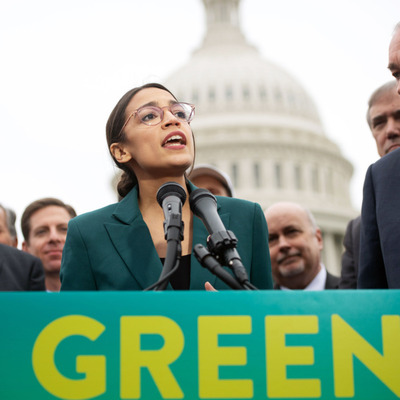In 2050 Green Power Generation In US Will Total 42% - Hmmm EV's To Solve A Problem?
EIA projects renewables share of U.S. electricity generation mix will double by 2050

SEE ALSO: No Climate Benefit From Electric Vehicles Until All Of Us Are Dead
In its Annual Energy Outlook 2021 (AEO2021), the U.S. Energy Information Administration (EIA) projects that the share of renewables in the U.S. electricity generation mix will increase from 21% in 2020 to 42% in 2050. Wind and solar generation are responsible for most of that growth. The renewable share is projected to increase as nuclear and coal-fired generation decrease and the natural gas-fired generation share remains relatively constant. By 2030, renewables will collectively surpass natural gas to be the predominant source of generation in the United States. Solar electric generation (which includes photovoltaic (PV) and thermal technologies and both small-scale and utility-scale installations) will surpass wind energy by 2040 as the largest source of renewable generation in the United States.
The AEO2021 Reference case projects that the natural gas share of the U.S. electricity generation mix will remain at about one-third of total generation from 2020 to 2050. The natural gas share of generation will remain stable even though natural gas prices will remain low (at or lower than $3.50 per million British thermal units, in real dollars) for most of the projection period. This stability occurs despite significant coal and nuclear generating unit retirements resulting from market competition as regulatory and market factors induce more renewable electricity generation.
The share of natural gas-fired generation in the United States will remain relatively constant through 2050, as projected in the AEO2021 Reference Case, and the contribution from the coal and nuclear fleets will drop by half. Through 2050, the share of electricity generation from renewables will double. Wind will be responsible for most of the growth in renewable generation from 2020 through 2024, accounting for two-thirds of the increase in that period.
After the production tax credit (PTC) for wind phases out at the end of 2024, solar generation will account for almost 80% of the increase in renewable generation through 2050. EIA assumes that utility-scale (and commercial) solar PV facilities will receive a 30% investment tax credit (ITC) through 2023, which will then be reduced to 10% beginning in 2024 and lasts through 2050. Residential solar PV will also receive a 30% ITC through 2023, which will expire in 2024.
Because renewable energy technology costs and natural gas prices are key determinants of these projections, EIA explores sensitivity cases with varying levels of both renewable costs and natural gas price trajectories. Accordingly, the renewable technology share of generation will be higher in the Low Renewables Cost and High Oil and Gas Resource cases, relative to the Reference case, and the share of generation from renewables will be lower in the High Renewables Cost and Low Oil and Gas Resource cases.
Principal contributor: Kenneth Dubin
>Reducing US Emissions Benefit - Zilch!
The Biden administration's "Climate Czar" -- John Kerry -- last month acknowledged that Biden’s agenda wouldn’t have the desired impact in the global climate fight.
“We could go to zero tomorrow and the problem isn’t solved,” Kerry said, noting that almost 90% of global emissions come from outside the U.S.
The U.S. was the world’s second-largest CO2 emitter last year, accounting for 15% of total emissions, according to Earth Systems Science Data.
U.S. energy-related CO2 emissions have since 2007 declined eight of the past 12 years, falling from 119 million metric tons to 102 million metric tons, the U.S. Energy Information Administration said.
While emissions are falling in the U.S., the trend, barring the 2020 impact of COVID-19 lockdowns, is higher in China and India, the world’s largest and third-largest emitters which account for 28% and 7%, respectively, of the world’s total.
aimed at slowing the spread of COVID-19 for months eliminated nonessential travel around much of the world, resulting in 2020 global carbon emissions falling by about 7%, the largest annual drop ever reported, according to a study conducted by the Global Carbon Project.
Emissions from the world’s biggest emitters were down across the board – falling 2% in the US, 11% in the EU, 9% in India, and 1.7% in China.
While Wrightstone believes the decline in carbon emissions is “significant,” he notes there was no drop in the levels of atmospheric CO2.
Carbon dioxide levels in the atmosphere since the Industrial Revolution have risen from 280 parts per million to more than 400 parts per million today. They continue to rise.
says the theory behind Biden’s climate plan is that a carbon taxation scheme and the regulation of the oil, gas and coal industries out of existence would lower CO2 emissions, resulting in reduced greenhouse gas warming from C02.
The problem, he says, is that there has been no evidence of “any atmospheric CO2 levels being reduced.”
There's “no doubt we're in a warming trend” that started 300 years ago, said Wrightstone, who believes modest warming and increasing levels of CO2 benefit Earth’s ecosystems and humanity.
“Those natural forces that cause temperature to rise for the first two hundred and fifty years did not suddenly cease in the middle of the 20th century,” he added. “Whatever this plan is and there's really no evidence that it will do anything to help.”



